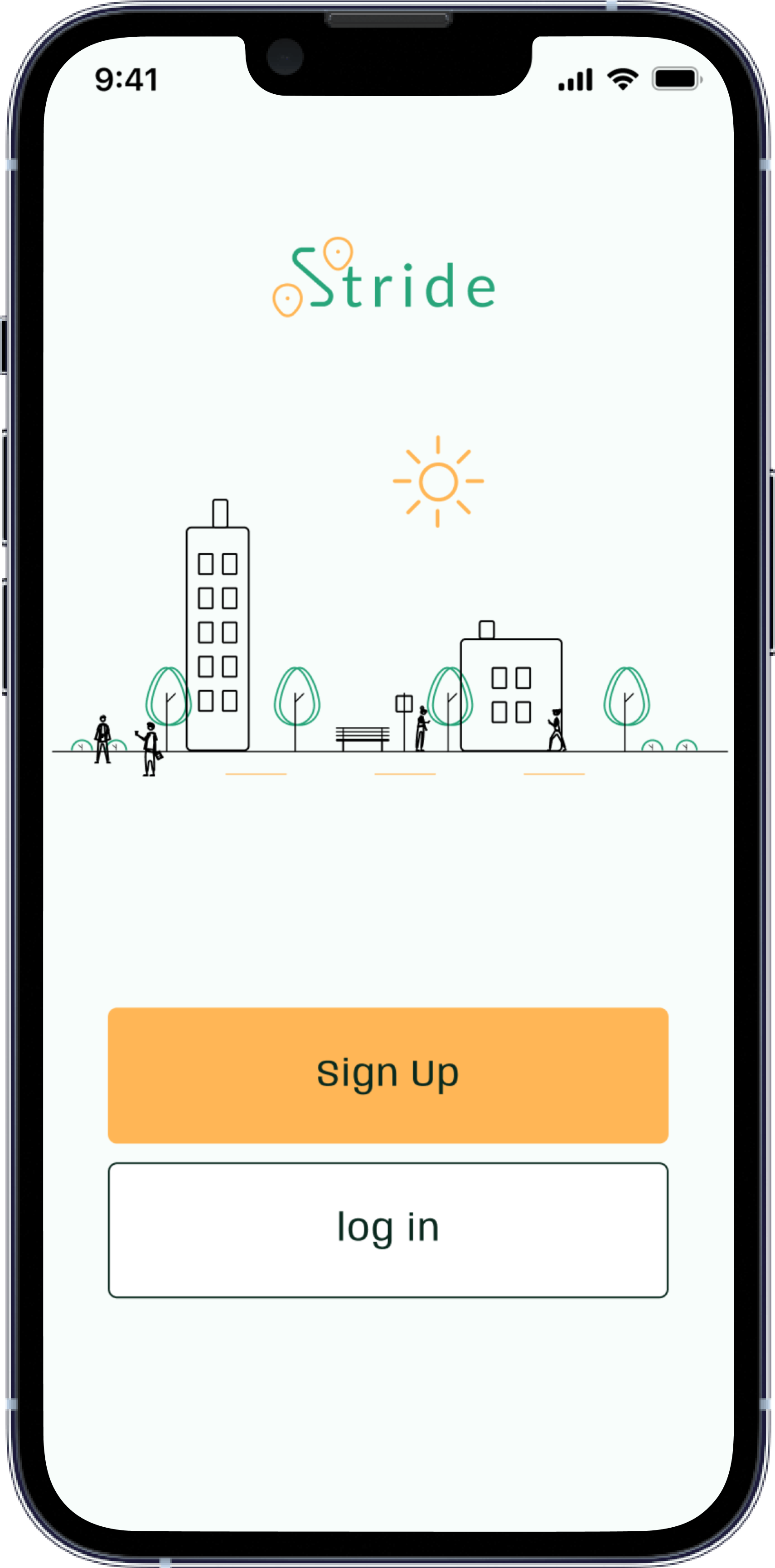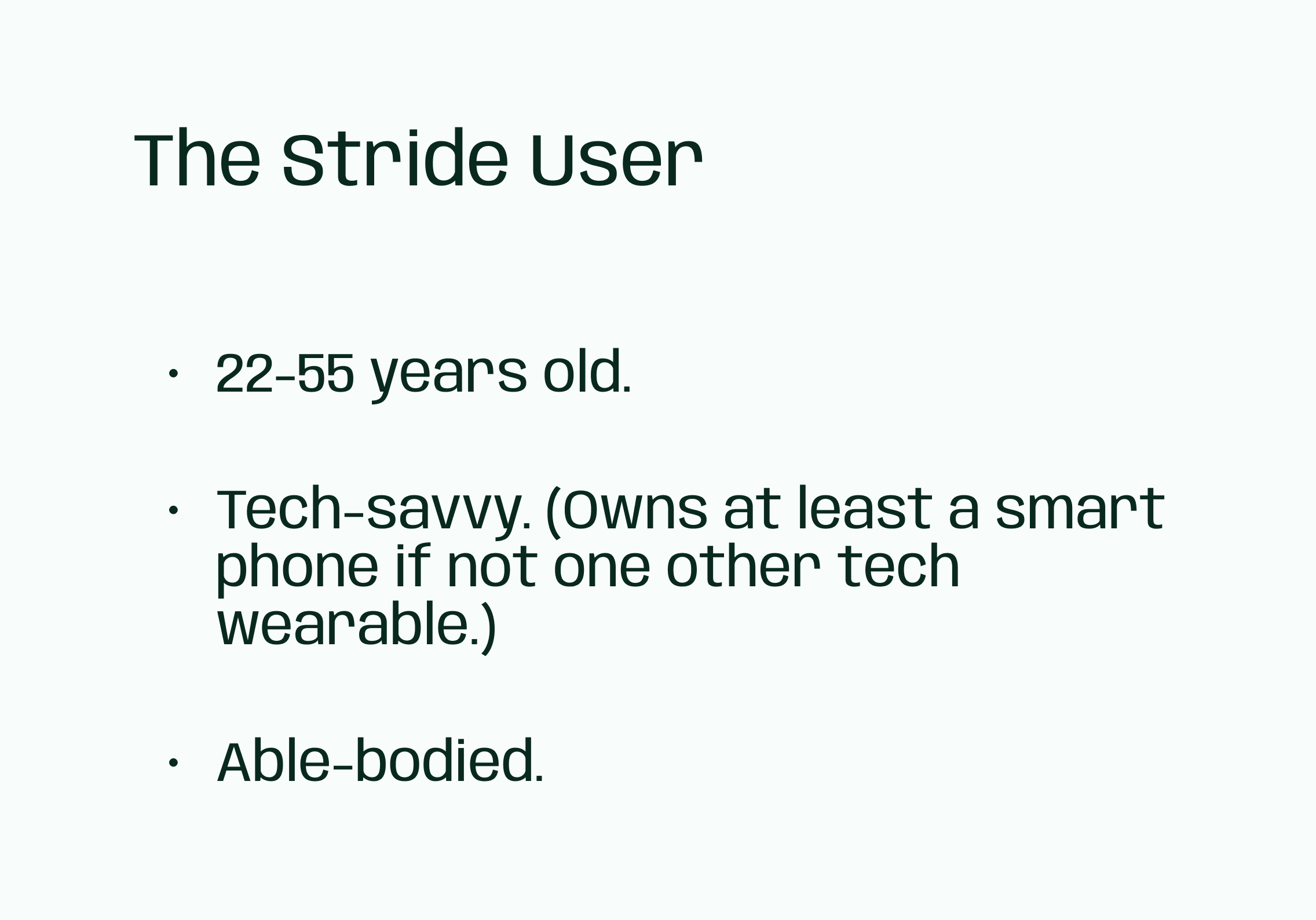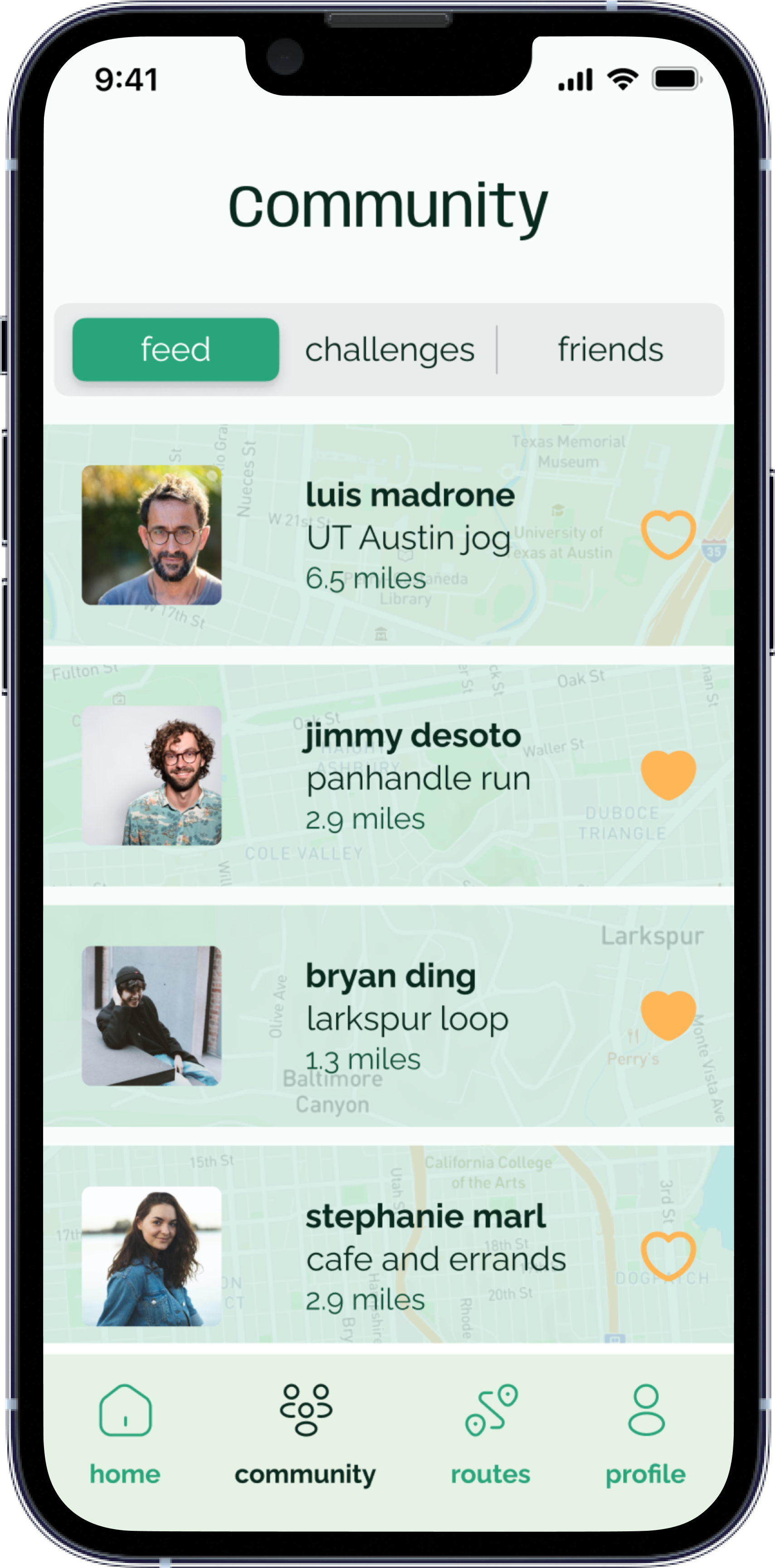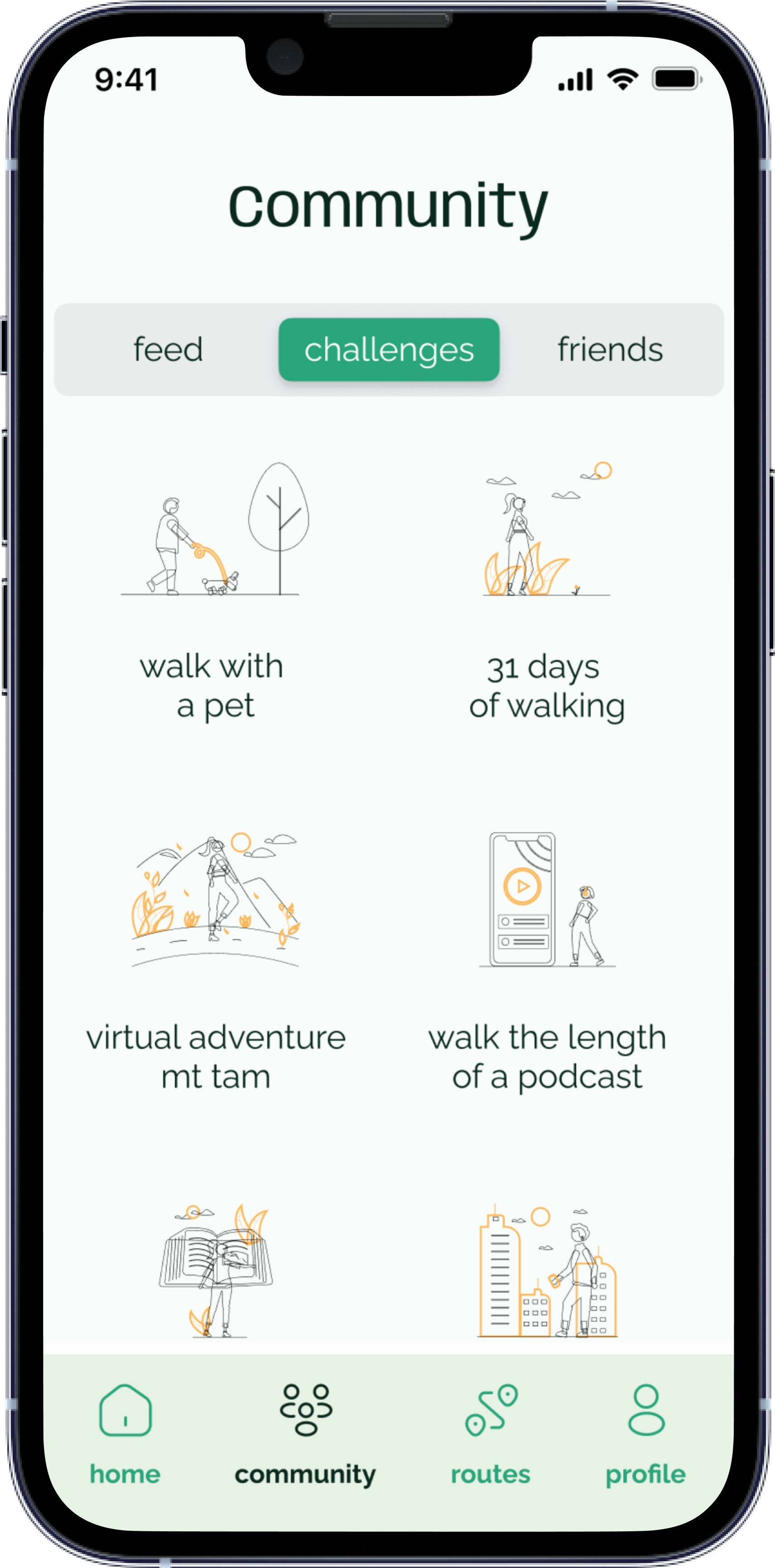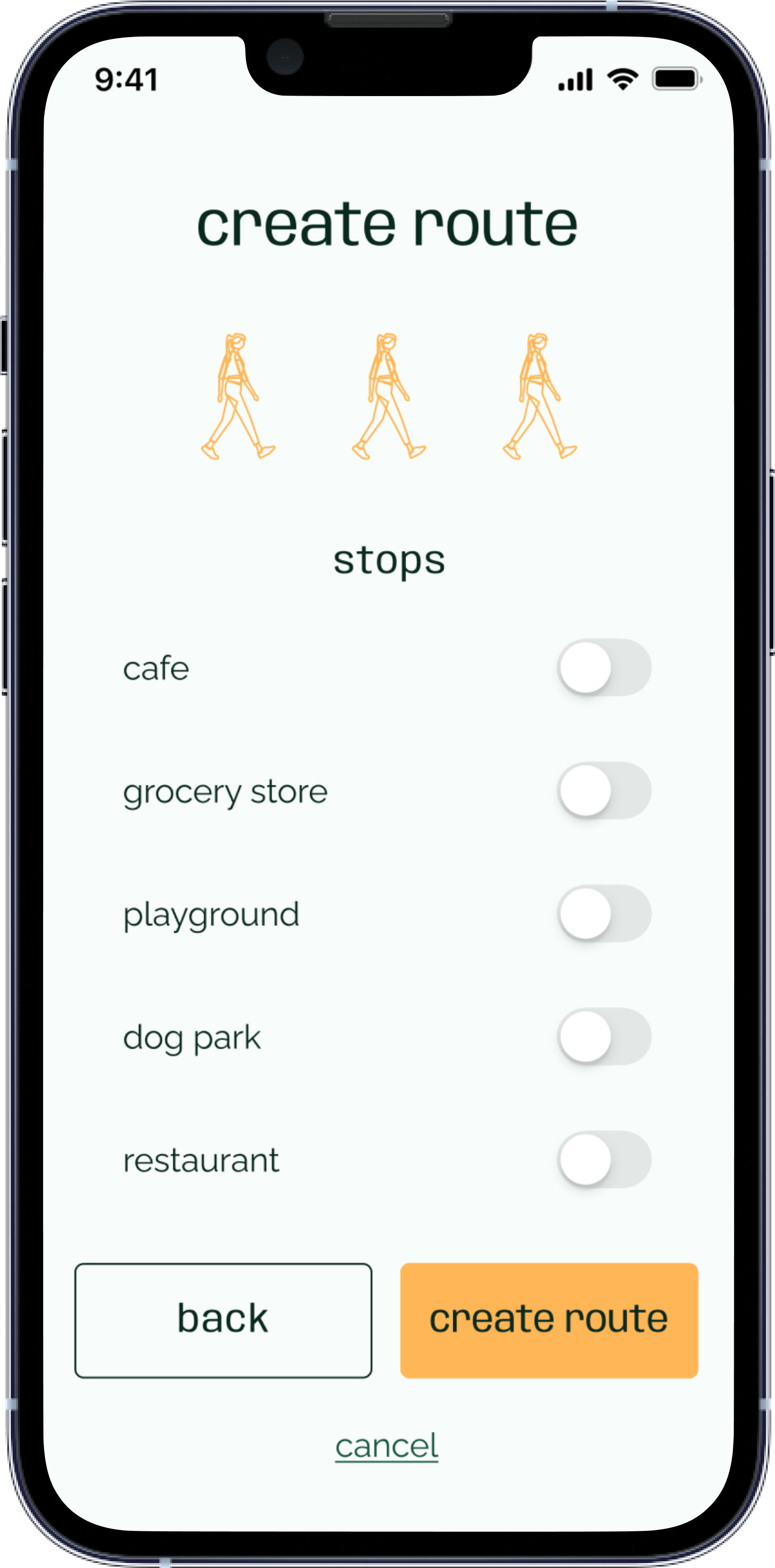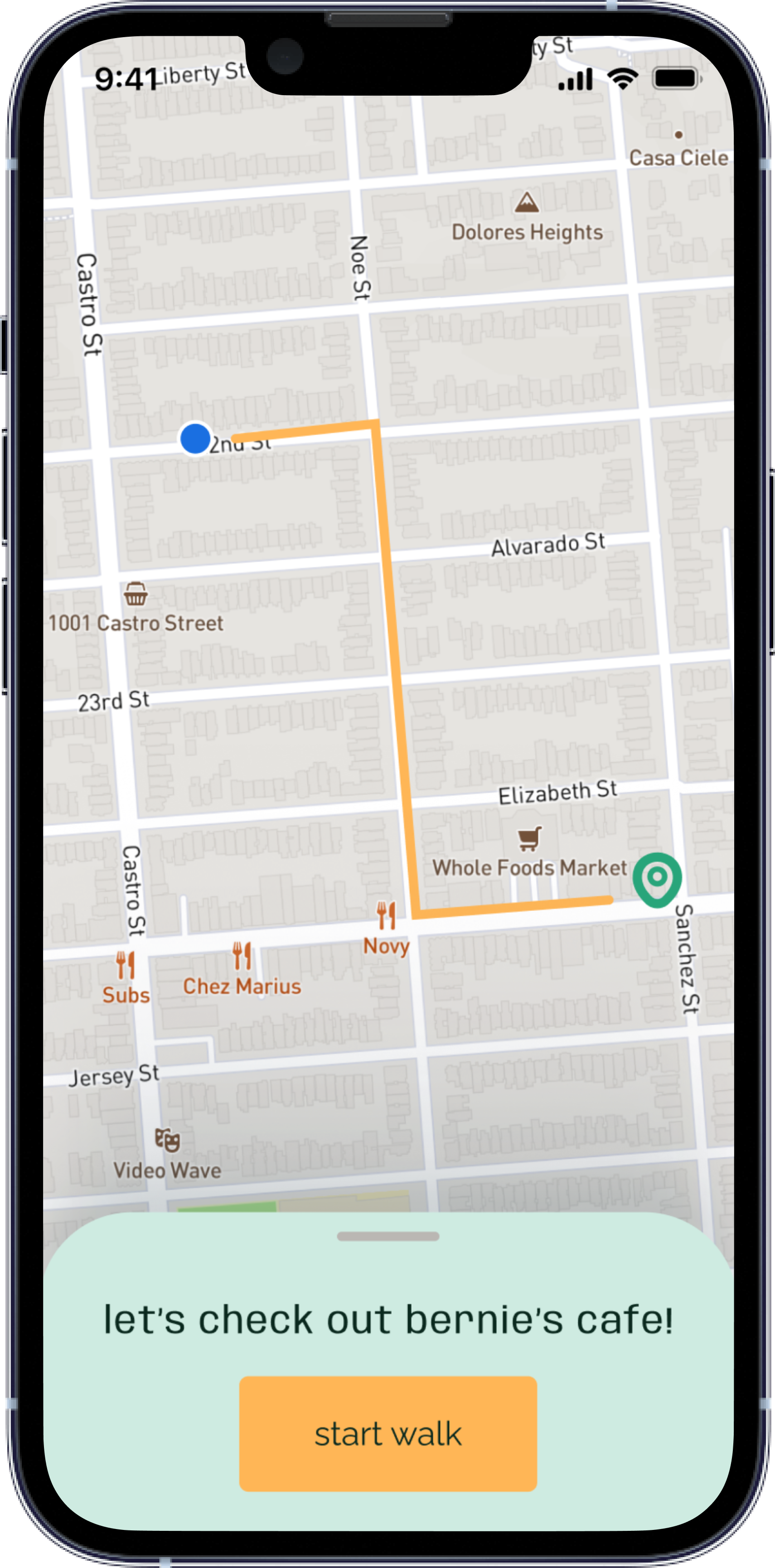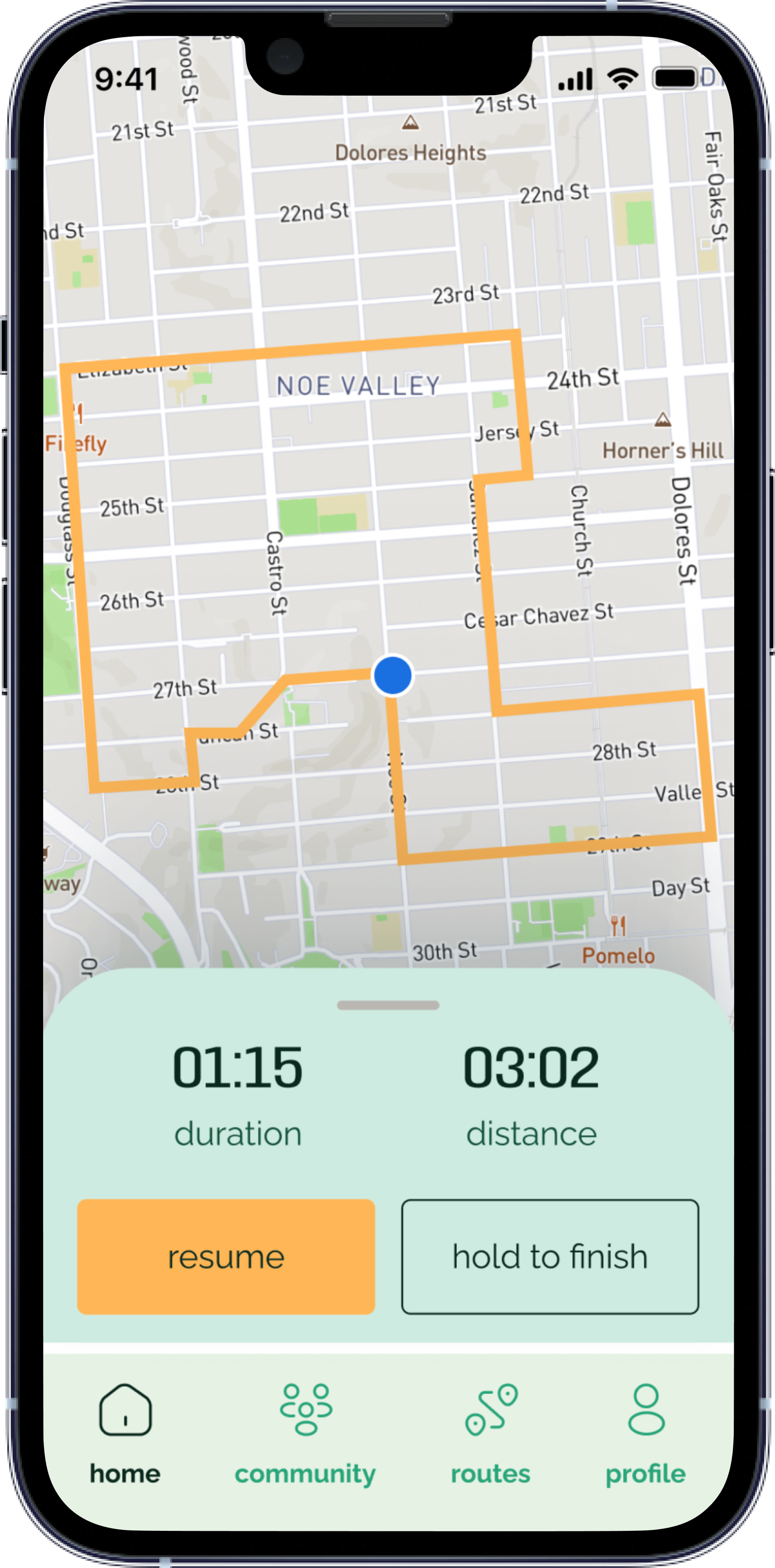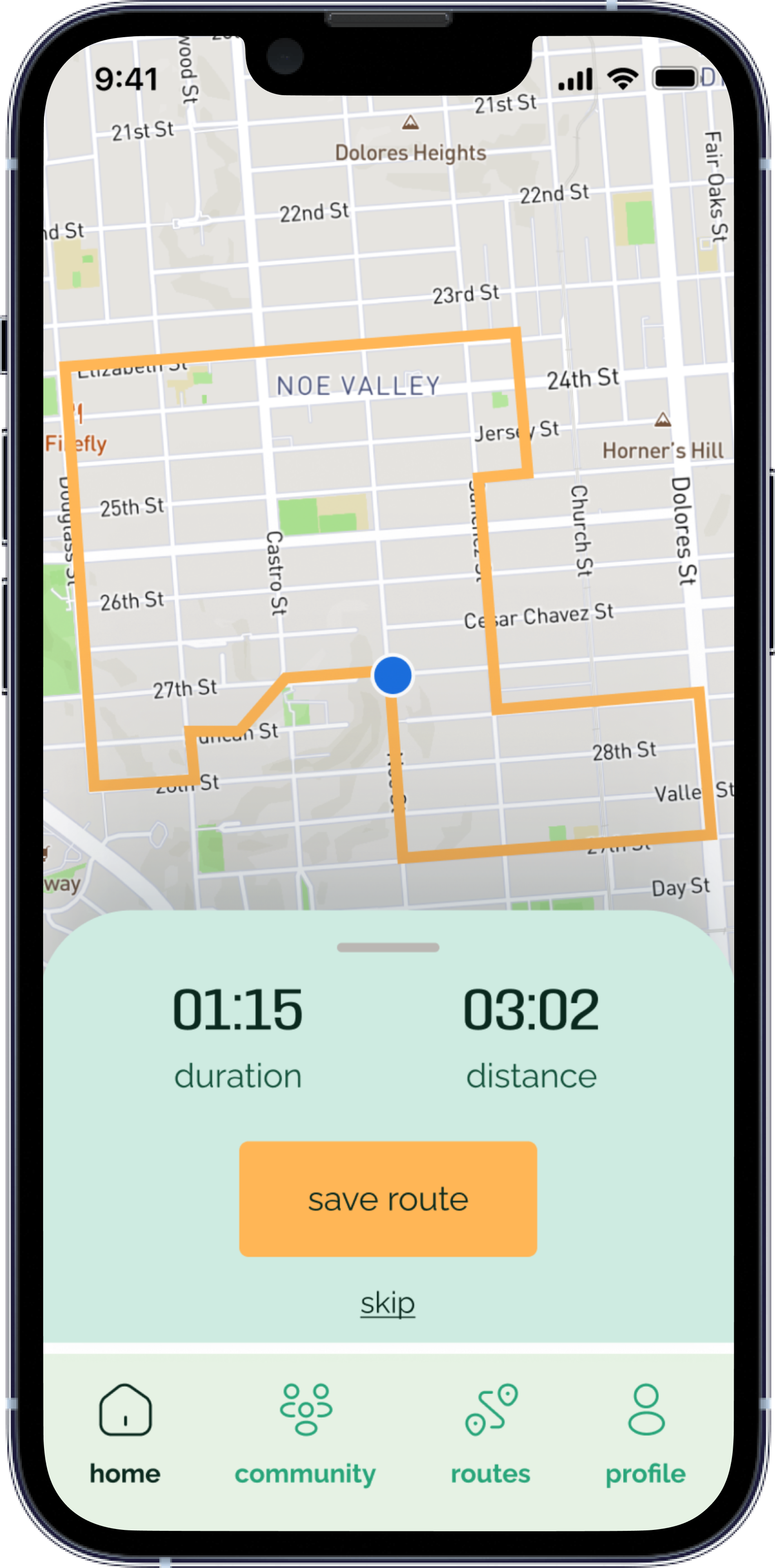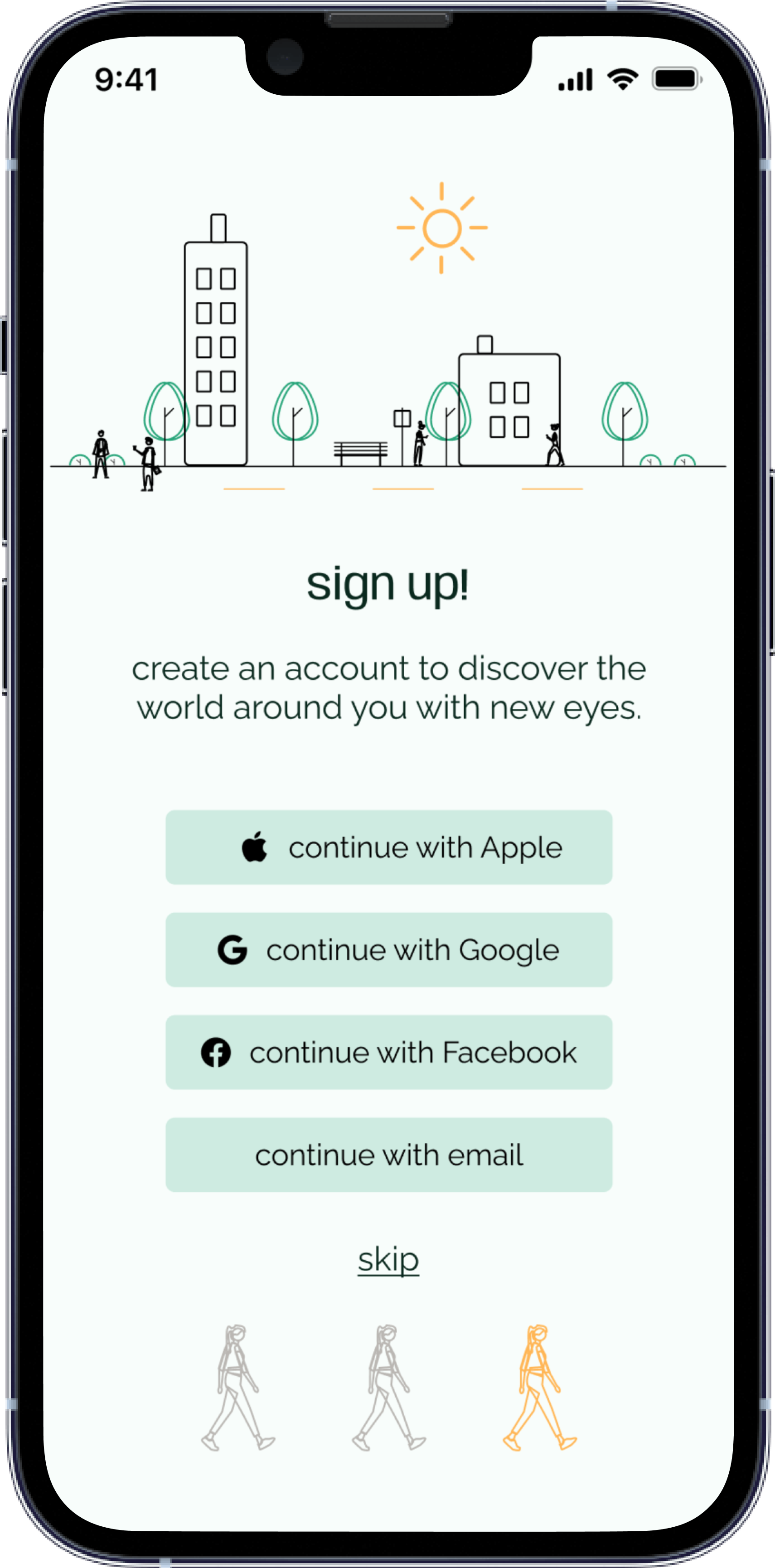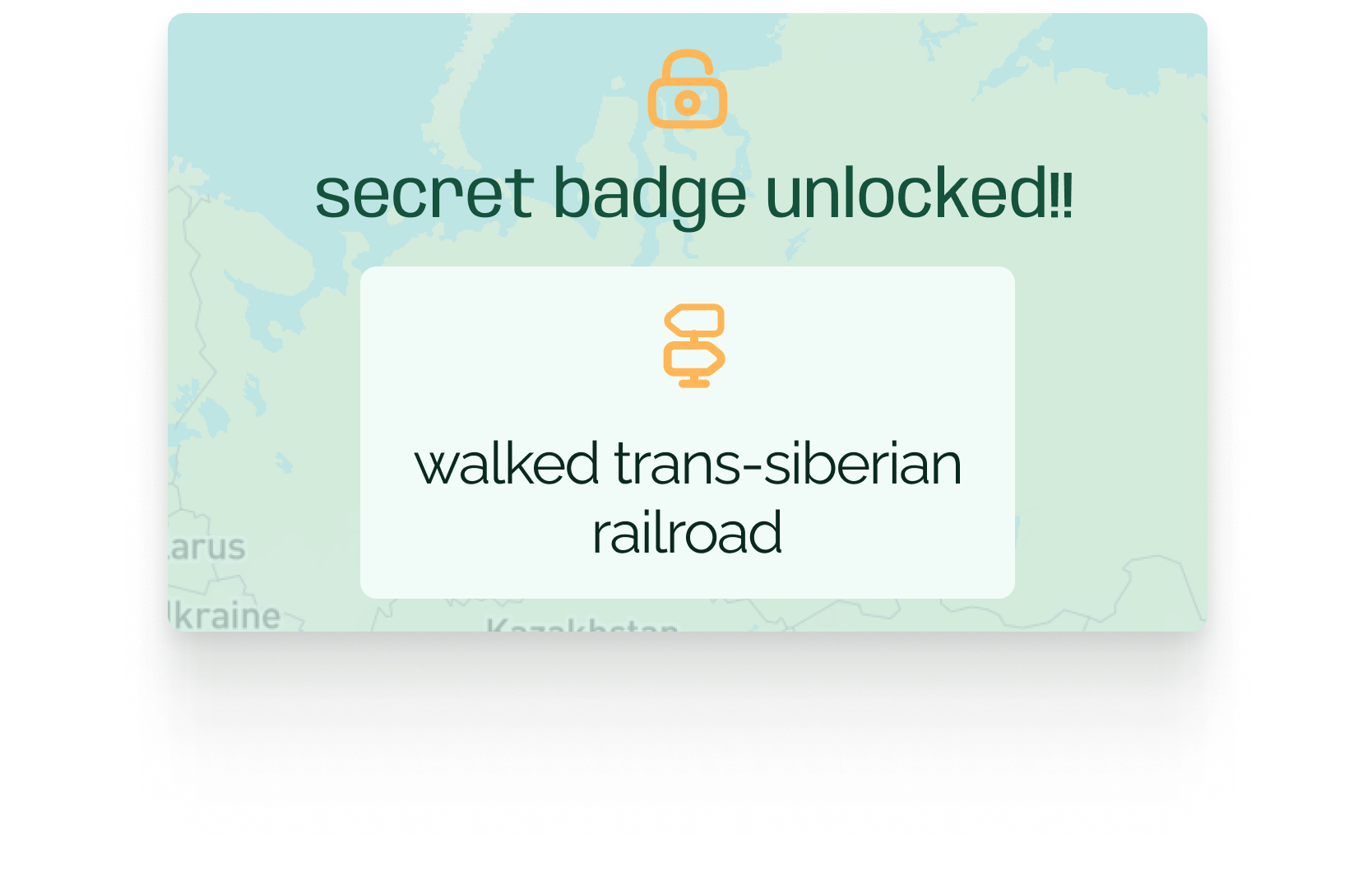Stride
Finding new ways to take a daily walk.
Onboarding sequence for Stride
Stride is a mobile iOS app built from a need to motivate people to take daily walks. There is a subset of healthy individuals who understand the benefits of walking but are unenthusiastic about walking unless there is the motivation of exploration or utilitarianism. Stride was created to address that need.
Background
Over the pandemic when we were asked to shelter in place it suddenly became glaringly clear how important getting outside, walking and having a breath of fresh air was. Many of us had taken all of these things for granted, walking to and from work, walking to meet friends and walking to grab a coffee suddenly all disappeared and became fraught with anxiety.
Tools: Figma, Maze
Role: UX Researcher, UI Designer
Duration: 80 hours
The Problem
Though many people fully understand the mental and physical benefits of walking every day many struggle to walk “just for the sake of walking”. People who normally got their daily walk in during their commute or their lunch hour were suddenly left high and dry, utilitarian walks were no longer deemed safe and they struggled to adapt their walking habits.
Pre-pandemic the average person walked about 5500 steps a day, during the pandemic that count dropped about 10%.
The Objective
How might we incentivize people to take daily walks?
As we begin to (hopefully) come out the other side of this pandemic we are able to once again meet up with friends, go into our offices and grab an afternoon coffee but we are now so much more aware of how important it is to take a daily walk. As schedules become busier it becomes harder to fit in a walk and it becomes easier for us to leave it by the wayside.
Technology allows us to discover, keep track of and gamify our behaviors which is why I wanted to explore this problem space and try to create an app to address it.
Through interviews I was able to better understand the frustrations and motivations of people who knew they should be walking more but lacked the interest in doing so. To start the process I created a breakdown of the ideal user for Stride so I would know who to recruit for interviews.
The ideal Stride user
After conducting interviews I had a wealth of data but it was a bit amorphous, creating an affinity map helped synthesize that data. Seeing a breakdown of interviewees motivations and thoughts about walking helped guide what features Stride would need to be successful.
A breakdown of motivations for walking.A breakdown of thoughts about walking.
A breakdown of fitness apps used by interviewees.
I also asked interviewees which fitness apps that used or had used in the past to better understand which apps I needed to focus on for competitive analysis. Instead of yielding answers for my competitive analysis I ended up learning more about how interviewees liked to measure their physical activities. Interviewees were less interested in measuring their steps and much more motivated by the distance traversed.
I created the persona “Will Dempsey” so I could begin to tell the user stories that would shape Stride. Will was an amalgamation of several interviewees. He fell into the category of “workaholic”, a user who worked from home everyday and struggled to find balance and time for walks in his every day life without the convenience of a commute.
User persona Will Dempsey was created to inform user and task flows.
Using my affinity map and notes from user interviews I chose Map My Walk, Strava, and Fitbit to examine more closely in my competitive analysis. At first I thought I wanted to examine and compare the features of each app but I quickly realized that the discrepancies in usability were far more telling. I knew that Stride needed to be welcoming, calming and simplistic in order to overcome the user’s motivation barriers. If users struggled to understand the basic navigation of the app then it wouldn’t matter how many features I included.
A competitive analysis of Map My Walk, Strava and Fitbit.
After running running a competitive analysis I was struck by how many of the fitness apps felt impersonal and overly complicated. Many interviewees already had a fitness regiment that they adhered to outside of their walks, some were aided by wearables and apps but their walks weren’t being motivated by their existing apps or wearables.
Before launching into a user flow I created a set of task flows that I could later knit together in order to track Will’s user flow of “Taking a Walk”. These task flows not only helped me understand the user journey that I was creating but they also guided my decisions for the Information Architecture of Stride and eventual sketches and prototyping.
New user onboarding flow
Saving a new route task flow
Will’s user flow of taking a walk via Stride. (Click to enlarge)
Before I could start sketching anything I needed to create a map for Stride. It was important to know which screens I would need to design before I started ideating and I relied on my flows to inform the information architecture of the app.
It was key that Stride had the necessary sections that its competitors have but it also needed to remain relatively simple for user navigation and scalability.
Stride’s Information ArchitectureWireframes
I sketched some simple screens based on the user persona and flows that I had mapped. One thing that I kept in mind was that during covid the traditional feelings of community started to evolve. Through user interviews I started to better understand how people defined community over the past two years and how I could translate that into my application. We all craved a sense of belonging and it was important to me that what I created helped foster that feeling.
Sketches of community and profile screens.
“During lockdowns walking was the only semblance to normalcy that I had.”
Interviewees were motivated to walk by a sense of community, especially during covid. Users can interact with their friends’ routes by liking them or even taking the same walking route. Taking beloved routes in new cities is a great way to experience the city like a local. Users can also participate in various challenges in order to motivate themselves and earn badges. The friend list displays users’ lifetime mileage and the badge they have most recently received.
Community feed screen
Community challenges screen
Community friend list
“It’s not the journey, it’s the destination for me.”
The uniting factor amongst interviewees was the agreement that walking was beneficial but frustrations ranged from walking feeling aimless to having trouble finding the time to take them. Interviewees mentioned a range of motivations for walking, many were motivated by the mental and physical health aspects but also needed the added motivations of exploring or food. Knowing this would eventually lead me to invent the feature “create route”. Route creation allows the user to set a time or distance limit and add stops in order to create a custom route generated just from their personal preferences.
Users customize their routes based on a series of preferences.
Customized walking route“Walking is meditative for me but I need to know the route first.”
The home screen is designed to launch the user straight into a walk, removing any sort of obstacles that might dissuade them from getting outside and moving. They are greeted by a personalized welcome message and oriented with a map of their current location. During their walk they can review their route which is mapped in real time by Stride. Once they finish their walk they have the option to save and name it for sharing and re-walking at a later date. Saved walks can be seen and taken by the user’s friends as well.
Home screenPaused walk screenSave walk screenName your walk modalUsers can save their preferred routes to take again and share with friends.As I started constructing the screens I had a creeping fear that this app was too simplistic. After running user testing it became clear that the app was perfectly functional but I felt strongly that it lacked a playfulness that would set it apart from the other fitness apps.
Challenges
It was difficult to fully overhaul the UI design of the app due to time constraints. The first iteration was simplistic and too elementary-looking. It looked more like an app for first graders and greatly lacked the polish and sleekness that I knew would appeal to adults.
With the remaining time that I had I started adding illustrations in order to humanize the design. Suddenly the app went from looking bare to having a personality. The vector illustrations added a sense of playfulness while also adding cohesion to the design. The color palette was also overhauled to be analogous which made the design appear more sleek, unfortunately it also brought contrast issues. Finding the balance between analogous colors and accessibility was difficult, colors that worked well together often didn’t pass accessibility tests.
Sign up screen with breadcrumb vectors
User profile displays badges earned along with weekly and lifetime walking statistics.
In my iterations I strove to make the design more cohesive, introducing vector drawings that were sprinkled through the screens. Introducing the vector drawings throughout the design along with pops of color helped liven up the design without over-cluttering it. I personalized more of the screens, including named greetings and added surprises in the form of secret badges that could be unlocked with various walks.
Badge modal
Adding secret challenges that unlock rare badges helps to celebrate the user’s mileage in new ways and urges the user to further explore the app.
Reflection and Next Steps
Creating Stride challenged me to build an app around the simple act of walking while enticing the user to return to it time and time again. Many times I struggled with how I could communicate a sense of wonder and excitement through design without overcomplicating the UI. I would also spend more time thinking about the user interactions within the design. This would require more usability testing and interviews with users but I know that it would bring more spark into Stride.
I would like to add a feature for users to meet up for walks more easily. Stride is currently built for users to explore their own communities but user research reminded me that people deeply value the relationships that they have with each other. Interviewees mentioned enjoying their walks more when they walked with a friend or called a love one. I would create a feature that could integrate with the user’s calendar thereby setting aside the time for both walkers to walk, chat and take in their surroundings together.
